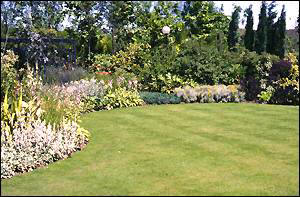
Choosing Lawn Grass
CHOOSING THE RIGHT LAWN GRASS FOR YOUR REGION
Lawn grasses fall into two basic categories: cool-season and warm-season (subtropical). Each group comprises a variety of plants with varying water needs. For more information on specific grasses, consult the individual listings in the Western Plant Encyclopedia
COOL-SEASON GRASSES withstand winter cold but typically languish in hot, dry summers. Most grow best in the Northwest; in parts of the Rocky Mountains with usually) abundant summer rainfall; and in areas where marine influence tempers summer heat. When planted in other regions, most require extensive summer watering. Cool-season grasses are often sold as mixes of several kinds; even if one of them is not adapted to the soil or sun and shade conditions in your garden, chances are that others in the package will do well.
 Bent grasses (Agrostis). Fine-textured
grasses requiring ample water and more care than other lawn grasses. Grow in acid soil, in sun or light shade. Mow at
1/2 to 3/4 inch. Sold as seed, sod.
Bent grasses (Agrostis). Fine-textured
grasses requiring ample water and more care than other lawn grasses. Grow in acid soil, in sun or light shade. Mow at
1/2 to 3/4 inch. Sold as seed, sod.
Crested wheatgrass (Agropyron cristatum). Light bluish green grass makes for a tough, very drought-tolerant lawn. Grow in sunny areas; adapted to Rocky Mountains and High Plains. Goes dormant and turns brown in hot weather. Mow at 2 inches. Sold as seed.
Fine fescue (Festuca rubra and others). Fine-bladed grasses that succeed in well-drained soil in shaded sites. Fairly drought tolerant. Sometimes blended with Kentucky bluegrass or perennial ryegrass or to overseed warm-season grasses. Mow at 1-1/2 to 2 inches. Sold as seed.
Tall fescue (Festuca elatior; also called coarse fescue). Tough grass that tolerates heat and some drought and flourishes in sun or shade. It freezes out in the coldest climates. Newer selections (dwarf tall fescue) are finer bladed, deeper green. Mow at 2 to 3 inches. Sold as seed, sod.
Kentucky bluegrass (Poa pratensis). Classic grass for cooler regions. Needs regular water. Takes sun, light shade. Mow at 2 to 2-1/2 inches. Sold as seed, sod.
Perennial ryegrass (Lolium perenne). Deep green grass that does best in sun. Needs frequent watering. Used as year-round lawn in cooler regions or to overseed winter-dormant grasses. Mow at 2 inches. Sold as seed, sod.
WARM-SEASON GRASSES thrive in hot weather but turn brown in cold winter weather. Gardeners who want a year- round green lawn sometimes overseed these warm-season grasses with some types of cool-season grasses for the colder months.
Common Bermuda grass (Cynodon dactylon) Good, drought-tolerant lawn for large, sunny areas. Invades shrub plantings and flower beds by seed and spreading roots if not contained. Mow at 1 inch. Sold as seed.
Hybrid Bermuda grass (Cynodon). Hybrid Bermuda is similar to common Bermuda, but it's finer textured and does not self-sow. Mow at 1/2 to 3/4 inch. Sold as sod, sprigs, plugs.
Blue grama (Bouteloua gracilis). Tolerates drought, extremes of temperature, and a wide range of soils. Does best in sun. Makes a better-quality turf when blended with buffalo grass. Mow at 2 to 3 inches. Sold as seed.
Buffalo grass (Buchloe dactyloides). Very drought-tolerant lawn for sun; slow growing. Mow at 3 inches. Sold as seed, sod, plugs.
St. Augustine grass (Stenotaphrum secundatum). Adapted to wide range of soils but does best along coast. Grows best in sun but tolerates shade. Needs regular water. Stolons can invade other parts of the garden. Mow at 1-1/2 to 3 inches. Sold as sod, sprigs, plugs.
Zoysia (Zoysia). Tolerates drought and heat; takes sun or shade. Mow at 1 to 2 inches. Sold as sod, sprigs, plugs.